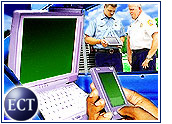
National leaders reviewing the emergency response and communication during and after the devastating terrorist attacks of 9-11 are looking to the private sector to bolster readiness at the same time some local governments are considering 802.11 wireless technology, or WiFi, as the basis of their own emergency communications systems.
While previous and current efforts have focused on ensuring that WiFi hotspots, which act as base stations in public and professional settings, and wireless networks do not interfere with existing emergency radio communications and response, the technology now is being seen as a more efficient method.
However, WiFi is constrained by issues including coverage and cooperation among providers, and it is unlikely to be the basis of nationwide improvements in emergency preparedness, according to analysts.
Private Communications
Nevertheless, the 9-11 Commission hearings this week have highlighted the need to synergize systems and spectrum to ensure various agencies can communicate reliably and efficiently.
“We will focus on private sector emergency preparedness and the importance of nationwide standards,” said a statement from 9-11 Commission Chair Thomas Kean and Vice Chair Lee Hamilton.
“We will focus on communications,” the statement continued. “Reliable communications, across agencies, is essential to situational awareness, effective coordination and implementation of decisions.”
Avoiding Wait with WiFi
Gartner research vice president Phil Redman told TechNewsWorld that many local governments, including those in Oakland, Ottawa and Toronto, are looking to WiFi as a less-expensive, more-immediate solution to emergency communications.
“It was no secret before 9-11 that there wasn’t any interoperability between state and local agencies,” Redman said, explaining that, despite the formation of a national forum, a lack of funding for new technology has kept the situation a problem.
Redman also said mobile radio maker Motorola was “very slow in delivering new technology in this space,” adding that improved mobile radios will not arrive for as many as three years.
While those factors have swayed some municipalities to WiFi, Redman said he doubts the wireless technology could be a viable stand-alone or even mesh — combined with other communications — solution because of coverage.
“It’s going to be questionable with coverage,” he said.
Redman added that WiFi does make sense as a supplemental or fill-in emergency communications approach.
Poor Coverage and Cooperation
Yankee Group program manager Roger Entner argued that issues of coverage, quality and the unlicensed spectrum used by WiFi will limit its potential as a means of emergency communication.
“With WiFi, we have such a hot-spot solution and such low reliability, it is not the best plan,” Entner told TechNewsWorld. “There is so little reliability in WiFi systems, and due to the dispersed locality of its operators, I wouldn’t rely on it.”
Entner added that wireless operators cannot even rely on one another and that use of unlicensed spectrum for emergency services is not practical.
“If you want interference-free spectrum, then pay for it,” he said. “The unlicensed spectrum is a problem.”











































